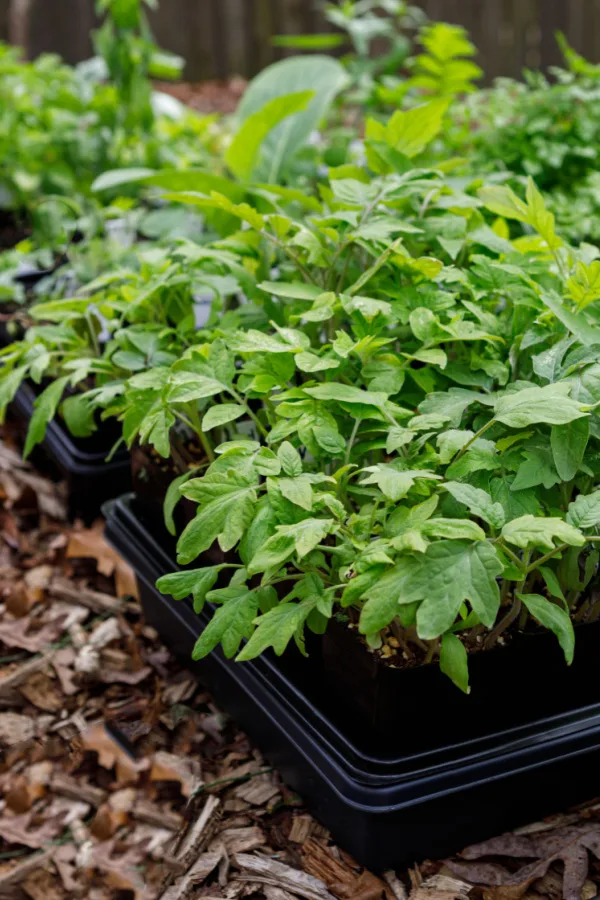If you are looking to plant and grow healthy and amazing tomatoes this year, today’s 5 five simple planting day secrets are sure to put you on the path to a big harvest!
Tomato plants are the most popular of all crops to grow at home – and for good reason. The powerhouse producers are perfect for growing in traditional gardens, raised beds, and even in containers. And with so many different varieties, colors, and flavors, tomatoes are also one of the most versatile garden crops as well.
From enjoying them in fresh salads and on sandwiches to turning them into slow-roasted sauces and flavorful salsas, tomatoes can do it all. That is, if you can get the plants off to a strong and successful start!

While it’s not difficult to grow tomatoes, there are a few things to keep in mind to ensure they stay healthy and produce loads of blooms throughout the entire growing season. And believe it or not, that all starts with what you do right at the time of planting.
In fact, as you will see below, producing a successful harvest tomato harvest starts even before you get the seedlings into the ground!
How To Plant Tomatoes For Success – 5 Simple Planting Day Secrets!
#1 Harden Off Your Plants Before Planting
Whether you start your tomato seedlings indoors or purchase transplants from a local garden nursery, it’s vital to harden off your plants completely before planting them outside.
Young tomato transplants need time to adjust and get used to the conditions of outside weather. Fluctuations in temperature, wind, and sun can all be a huge shock to plants that have been growing in ideal and controlled conditions. And that shock can cause serious issues for young plants.
The key to prevent this is to “harden off’ The plants, which is simply allowing them to slowly adjust and acclimate to the outside conditions over a period of a few weeks.

For plants you grew indoors, the process should begin two to three weeks before you will be planting them outside. When the outside temperatures are around 55º F, set the seedlings out in a protected area for a few hours a day. Be sure to keep them out of the wind and bring them inside if the weather turns bad.
This is even a good idea to do for transplants purchased in stores. Especially for transplants that were kept inside entirely in a greenhouse setting.
Gradually increase the amount of time the seedlings are outside. Eventually, keeping them out overnight as long as the temps don’t drop below 45º F. As the plants adjust, you can then start to move them to less protected spaces until the plants are outside 24/7.
Implement Crop Rotation – How To Plant Tomatoes For Success
The next secret to growing great tomatoes is one often overlooked by many home gardeners – and that is the practice of crop rotation – and can it ever make a huge difference in the health and productivity of your tomato crop!
Why is crop rotation so important? First off, tomatoes are very heavy feeders. It takes loads of nutrients and resources from the soil to grow large productive tomato plants. And by the end of a growing season, the tomato plants have likely depleted the soil where they grew of vital nutrients.
Unfortunately, if you grow those tomatoes in the same exact location again, the plants will likely struggle because of a lack of those nutrients. In addition, growing tomatoes in the same location also sets them up for soil-borne diseases and issues.

But by rotating your tomato plants each growing season to a new spot in your garden or a new raised bed, you greatly reduce the chances of any of the above issues occurring. For best results, never plant tomatoes in the same location for at least three years and replace the soil in containers yearly.
#3 Wait Until The Soil Warms Up – How To Plant Tomatoes For Success
While you might think the sooner you get your tomato plants in the ground the bigger and more productive they will grow – most of the time, the opposite is actually true. And that is a direct result of gardeners planting too early in soil that is way too cold.
Planting tomatoes too can cause a long list of issues for your plants. For starters, the cooler nights of early spring can keep plants from growing. And the longer they sit in cool soil, the more susceptible they become to rot and mildew.
In addition, planting too early puts plants at risk of getting hit by a frost or freeze. Unfortunately, even a light frost or freeze will damage young seedlings. Often it can be damage that affects the plant growth all season long.

The key is to not only allow the outside air temperatures to warm up but the soil temperatures as well. Tomatoes planted in warmer soil will be able to adjust and establish in the soil at a far faster rate. Even more importantly, they will be able to absorb nutrients better, resulting in a much faster growth rate.
For the best success with transplanting, the soil temperatures should reach – at a minimum – 60 to 65º Fahrenheit (F). You can use an inexpensive soil thermometer to test the soil’s temperature. If it registers as lower than 60º F, it’s not time to plant! Affiliate Link: Accurite Soil Thermometer
#4 Fertilize The Planting Hole – How To Plant Tomatoes For Success
Once the soil has warmed and the tomatoes have gotten used to the outside conditions, it’s time for planting. And when you do plant – it’s critical to fill that planting hole with all kinds of powerful ingredients your young tomato plants need for strong, fast growth!
When planting, start by adding in a few cups of finished compost in the hole. With that, add a quarter cup of worm castings and a two to three tablespoons of spent coffee grounds. All of the above are great all natural slow-release fertilizers. Even better, they all will leach their nutrients back into the soil at a perfect rate for young plants.
But don’t stop with just those three – it’s also important to add in powdered egg shells too! As the eggshell powder absorbs into the soil, it helps to provide additional calcium. Calcium that can build strong cell walls in your plants – and also prevent black rot and blossom end rot. See our article: How Egg Shells & Coffee Grounds Can Help Tomato Plants!
#5 Mulching For Success – How To Plant Tomatoes For Success!
Last but not least, it’s time to give your plants a thick coat of mulch. A four to six inch layer of natural mulch will do wonders to prevent weeds from sprouting around tomato plants. Weeds that can compete and steal valuable nutrients and moisture from the soil that should be going to your tomatoes!

In addition, mulch also helps to regulate the soil temperature. It keeps it from getting too cool on cold nights and too warm during overly hot and sunny days. Last but not least, a thick layer of mulch also helps keep moisture in the soil too.
Some of the best mulches to use around tomato plants are straw, shredded leaves, or grass clippings. Apply the mulch in a one to two-foot ring around each plant to completely cover the future root zone. When mulching, always leave a few inches clear right up around the stem. This will keep the stems from staying overly wet and eliminate any chance of rot.
Here is to getting your tomato plants off to a fast start on planting day this year!
Follow Our Facebook Page For Even More Great Tomato Growing Tips! I Grow Tomatoes Facebook Page
I Grow Tomatoes is a website created for those who love all things about tomatoes – from planting and growing – to cooking and canning! We publish two articles every week, 52 weeks a year. Sign up today to follow via email! This article may contain affiliate links.
